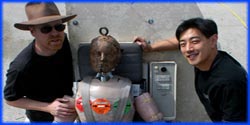


Premier Date: October 19, 2011
confirmed
Adam and Jamie set up two excavators on a barge and had a tugboat tow them 0.5 mi (805 m) into San Francisco Bay. Their goal was to keep control of the barge’s direction and maintain forward momentum toward the shore. The first attempt failed due to strong currents pushing them into the bay, but when they started closer to shore they were able to row to the dock.
confirmed (pure unadulterated fun)
Jamie operated an excavator set in the middle of a pond while Adam rode the board. After a few adjustments of bucket height and spin speed, Adam successfully stayed upright. He enjoyed himself so much that he invented a special category for this myth: “Pure Unadulterated Fun”.
confirmed
Adam met with an expert machinery operator to work out the details of attempting this feat. By carefully manipulating the boom, bucket, and tracks, he was able to lean the front end against the tailgate, then turn the cabin around and lift the rear end off the ground with the bucket so he could drive into the cargo bed.
confirmed
The Build Team obtained a plane with a fuselage similar to the one on the plane in the actual incident. After they assembled it and watched its owner take a test flight to confirm its airworthiness, Kari used a pair of clawed gloves to shred the relevant portions of the fuselage. As she and Tory started covering the damage with duct tape, Grant worked on the control surfaces needed to keep the plane stable in flight. The plane’s owner then taxied on a runway and took off, spending over 30 minutes in the air with no observable deterioration of the tape despite the wind and temperature.
confirmed
Using the same donated plane, the team ripped off every piece of the fuselage and covered the frame with tape. The removed material weighed the same as 5 rolls, but the team ended up using 17 rolls to build a layered skin intended to resist vibrations and rippling. When the plane was set up in front of a wind machine set to 50 mph (80 km/h), Grant and Tory saw no damage in the tape. A test pilot then taxied on the runway and took the plane for a short flight at an altitude of 5 ft (1.5 m), reporting no problems in strong wind gusts. Grant commented afterward that calmer winds might have allowed the pilot to take a longer flight at a higher altitude.
Previous: Episode 173: Walk a Straight Line